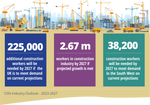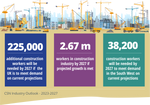What is hindering your market at the moment?
Understandably, we are seeing our clients tighten their belts in respect of investment into their assets. Whilst the markets continue to be challenging, our clients are being more selective about how they improve their assets and the CapEx they are willing to commit to enhance their holdings. With increasing vacancy rates, particularly for high street retail, our clients are facing larger overheads due to funding void service charges and utilities. The impact of capped service charges in a world where maintenance and utility costs have increased also affects their net income and therefore ability to reinvest. Business plans developed whilst interest rates were much lower are now more challenging to deliver, and clients are having to pick and choose the opportunities they believe offer the best return on investment.
What opportunities are you seeing in your market at the moment?
As investors look more closely at how their portfolios are performing, the basic functions carried out by property managers are becoming even more important, such as timely rent collection, service charge reconciliations and tenant engagement.
Whilst the investment market remains sluggish, clients have become more focussed on asset and property management matters and are taking the time to review their appointed agents. As a result, we are seeing an opportunity to pick up new mandates, where current agents are not performing as expected.
Our robust approach to the fundamentals of property management is clearly demonstrable to prospective clients and consequently, we have seen an increase in new instructions over the last 18-months. In addition, having a very broad client base, including institutional investors, property companies, developers and private wealth businesses ensures we have opportunities during the peaks and troughs of investment cycles, due to differing objectives and investment strategies.
What’s the biggest change you have seen in your sector throughout your career?
There are many, but the main one has been the specialisms created in Property Management over the years. When I started my career in 1995, property management was viewed as the poor relation of the industry, low margin, mundane and quite frankly boring! As Property Managers we performed all the day-to-day functions, including procurement (often relying on the yellow pages to find a suitable contractor for an urgent jobs) contract management, inspections, Health & Safety compliance, arrears management and tenant liaison.
As time moved on, the industry introduced Facilities Managers to deliver the onsite aspects of PM/FM and Accounts teams broadened their scope to include credit controllers and service charge accountants. Fast forward a few decades, and we now have specialist teams dedicated to ESG, customer experience, technology, health & safety, energy management and procurement.
This specialisation has allowed property mangers to focus their time and energy on working to achieve our clients’ objectives to maximise returns from assets, and overseeing exceptional service delivery to our occupiers. We have continued to develop our skills, to be able to offer our clients the best solutions in a constantly changing world, whether that involves improving BREEAM in use ratings, ESG credentials, development consultancy for new schemes or offering front of house services in managed buildings.
The stability of revenues from property management proved invaluable during the economic slowdowns and recessions throughout the 1990’s and it is now finally recognised for its value to our clients and our colleagues.
In seeking feedback from one of our clients recently, they advised that as their property managers, “we rely on you to work with us and we see you as integral to our performance.” The role of the property manager has clearly evolved and has become much more valuable to our clients over the last 30-years. In many instances, we know more about their assets than they do !
What are your predictions for the next 12-18 months, in your sector?
Predicting specific trends in commercial property management is challenging due to the dynamic nature of the industry and the unpredictability of external factors.
Focus on health and safety: The COVID-19 pandemic has heightened awareness of health and safety in the workplace. Property managers will need to continue to prioritise implementing and maintaining rigorous health and safety protocols to ensure the well-being of tenants and visitors
Sustainability initiatives: There will be a continued emphasis on sustainability and green building practices in commercial property management. The need for implementing energy-saving measures, promoting waste reduction, and seeking green certifications to attract environmentally conscious tenants will continue and will be a focus for all investors moving forwards.
Focus on Occupier Experience: Enhancing tenant experiences will remain a priority for commercial property managers. This will include offering personalised services, creating inviting common areas, and organising community-building events to foster a sense of belonging and wellbeing amongst occupiers.
Resilience Planning: Property managers will increasingly focus on resilience, planning to mitigate risks associated with natural disasters, cybersecurity threats, and other disruptions. This involves implementing robust contingency plans and investing in resilient infrastructure. The COVID-19 pandemic highlighted the importance of contingency planning so that businesses can continue to operate when challenging factors take place outside of their control. We will continue to be agile and forward thinking to navigate the evolving landscape and effectively meet the needs of clients, tenants, and stakeholders.
What advice would you give your younger self when you first started your career in property?
Don’t worry so much, it will all be OK if you continue to do your best! Believe in yourself, keep pushing forward and seize opportunities when they arise.
It is easy to say but much harder to implement this advice. However, things do have a habit of working themselves out. When I graduated in 1993, job opportunities were scare due to the early 1990’s recession, with each role attracting thousands of applicants. I offered to work for local practices for no salary so I could gain experience to achieve my APC. After a move to London for 12-months working for the Valuation Office and then securing a graduate role in Bristol in 1995, I was back on track to gain my APC.
30-year later, I’m now Head of Office with 53 staff, 15 business lines and revenues of £7.5 million. At times it’s been a struggle, especially when trying to balance family life with two children, however it has been worth it and I’m so pleased I didn’t give up in the early days when it was tough going.





























